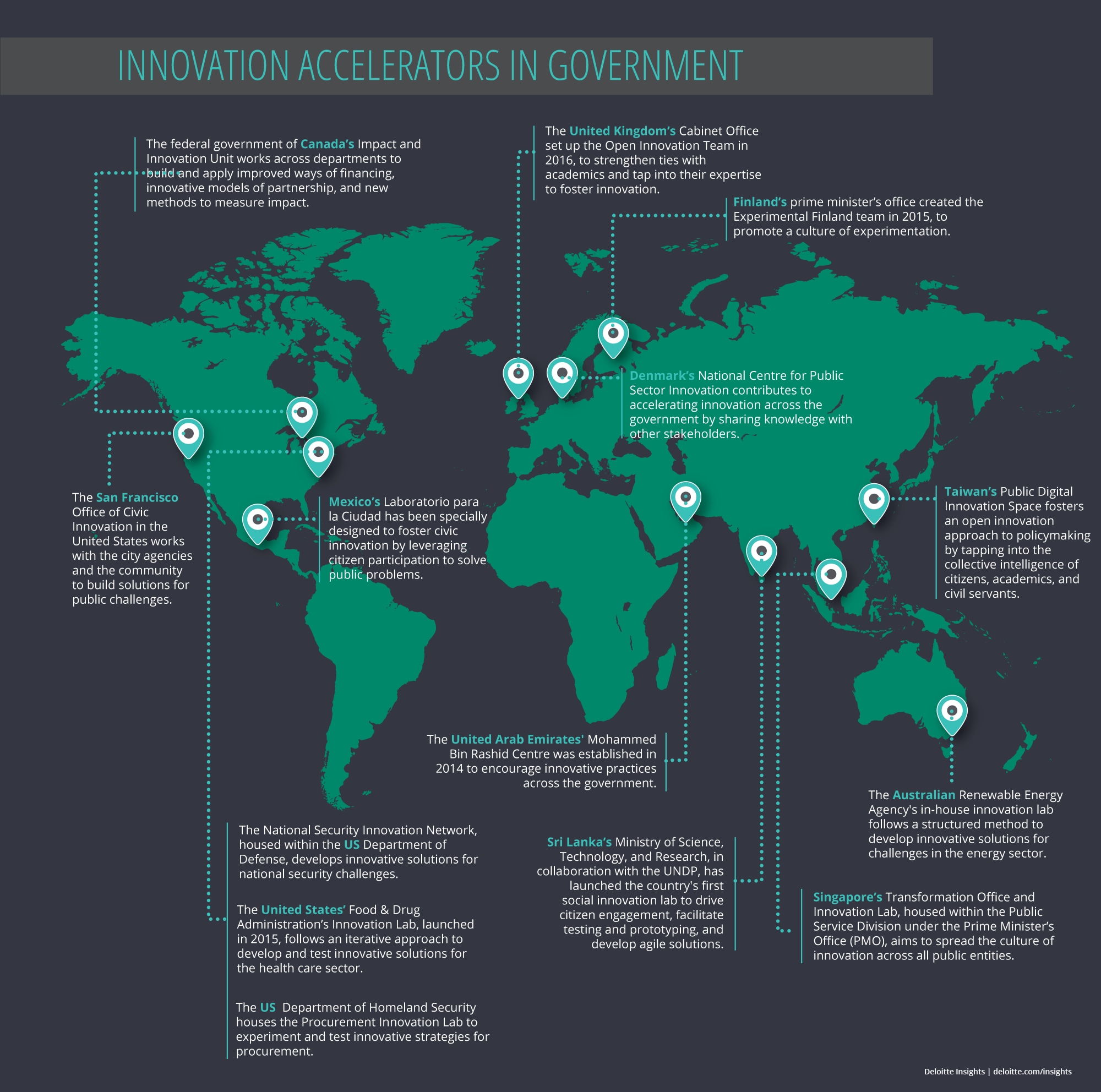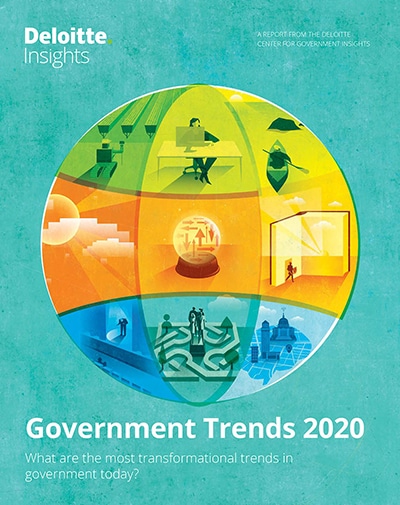
Innovation accelerators Creating safe spaces for government innovation
6 minute read
24 June 2019
Many public sector organizations have begun creating formal units that can focus on innovation without fear of failure. Here are four models organizations can follow to create such units.
A safe, entrepreneurial environment that tolerates and even celebrates risk-taking and the process of learning from failure is critical to innovation, especially when those innovation efforts are more transformative in nature. The more potentially disruptive a new approach or solution is to the status quo, the more quickly organizational antibodies will arise to mitigate the threat. And this is especially true in government, where expending tax dollars on unsuccessful endeavors is frowned upon, and failures in areas important to national interests—from health care to taxes to national security—are viewed as unacceptable by both government officials and taxpayers.
To mitigate these risks and allow promising solutions to be developed without succumbing to institutional risk aversion, many public sector organizations have begun creating formal innovation units. But these units vary widely in their activities and functions, and a key factor in the success of these units is whether or not they are actually designed in a manner that supports the activities they are supposed to be executing. Just as in architecture, form should follow function, and the most effective innovation units have carefully considered how to align their goals, activities, and supporting capabilities.
One simple way to begin thinking through how an innovation unit should be designed is to consider whether it is focused on getting its ideas from internal or external sources, and whether it is focused on solution development or driving innovation amongst other stakeholder groups.
Building solutions in-house (internal orientation, solution-focused). In the private sector, some of the most common innovation unit models are those focused on developing solutions in-house. From skunkworks, to test stores, to studios, these groups employ individuals with the skills to bring ideas to life as tangible solutions. These can include product designers, coders, social behavioral scientists, often employing agile and design-based techniques such as rapid prototyping, A/B testing, and wire-framing to explore the potential of new solution concepts at minimal expense.

In the public sector, groups such as the Mayor’s Office of New Urban Mechanics in Boston fulfill these functions by exploring new approaches for improving the lives of Boston’s citizens. By developing, testing, and evaluating new solutions, and subsequently turning effective solutions into sustainable programs, the team is an in-house solution provider for the challenges Boston faces.1 The US Digital Service provides a similar in-house solution development capability for the US federal government by building new digital products for a number of different agencies.2
Spinning in external solutions (external orientation, solution-focused). Other innovation units focus on identifying external solutions, and then modifying them for internal use. Much like a corporate venture group within a big company, these groups focus on “spinning in” promising solutions and adapting them as needed to a public sector context. These organizations often require horizon scanning and rapid acquisition capabilities to keep abreast of promising new solutions and acquire them for public sector use, as well as human-centered design skill sets to adapt the solutions to the needs of public sector stakeholders.
For example, the World Food Programme’s (WFP’s) Innovation Accelerator adapts new business models and technology for use in food supply chains and markets. It is not focused on inventing new technologies but rather “scaling up” solutions. The WFP awards US$150,000 to build out proofs of concept for promising ideas and then works directly with the solution originator to develop them for WFP mission needs.3
In the United States, the Joint Improvised-Threat Defeat Organization was created to continuously search for the latest commercial capabilities and rapidly acquire promising solutions for the US Department of Defense.4 And the US Department of Health and Human Services’ Biomedical Advanced Research and Development Authority fulfills a similar function for health in its Division of Research, Innovation, and Ventures, focused on identifying promising health security solutions in existing innovation ecosystems and making investments in these companies as part of a public-private partnership.5
Activating the innovation ecosystem (external orientation, enablement-focused). In the public sector, an organization doesn’t actually have to develop solutions itself to drive innovation in line with its operational or programmatic priorities. Because other organizations are often focused on the same or similar areas—from improving public health outcomes, to reducing poverty, to increasing access to educational opportunities—the greatest value can sometimes be derived from enabling others to innovate more effectively.
Some innovation units are designed to fulfill this “ecosystem activator” role by creating new incentives via prize challenges, enabling others to innovate through open data or convening other groups in activities such as hackathons. These organizations have to be able to quickly assess the other actors in their ecosystem, establish strong innovation partnerships, and identify the right role to play at the right time to create the greatest value. The Danish government supports a GovTech program to help tech startups deliver new solutions to create public sector value.
The Experimental Finland team was created in the Finnish prime minister’s office in 2015 to promote a culture of experimentation.6 The team has launched a digital platform called Kokeilunpaikka (meaning “place of experiment”) to encourage citizens to learn about experiments and also design their own. In one case, a group of nurses submitted the idea of robotic vests to help them lift ailing patients.7 And the KidneyX Innovation Accelerator—launched in 2018 as a public-private partnership between the US Department of Health and Human Services and the American Society of Nephrology—uses crowd-sourced prize challenges and other means to help early-stage startups develop innovative drugs and therapies.8
Facilitating innovation from within (internal orientation, enablement-focused). Finally, some innovation units function as internally focused catalysts, by making it easier for other teams within their organization or immediate network to innovate. These organizations perform functions such as training their organization’s staff members, providing mechanisms for staff to communicate their innovative ideas to organizational leadership, and releasing toolkits to help accelerate innovation efforts.
For instance, the Lab at the Office of Personnel Management, is the Federal government’s educational hub for building human-centered design capabilities across the public sector workforce, through project-based learning, a comprehensive design curriculum, and thought leadership on design in government.9 Similarly, the United Nation Development Program’s Innovation Facility helps country offices test frontier technologies and new approaches in an effort to deliver better results. Since its establishment, the Innovation Facility has supported over 140 country-level experiments, across 87 countries and territories.10
These models are not mutually exclusive, but they can help a government agency begin thinking through the kinds of activities to focus innovation efforts on. Many innovation units are hybrids of the above archetypes. However, thinking through the types of activities an innovation unit engages in is an important first step for identifying the organizational structure, skill sets, and infrastructure that will be required to make the unit successful.
It is also important to note that the existence of one of these innovation units does not preclude broader efforts to systematize innovation across an organization. The most effective and innovative leaders encourage their staff to take strategic risks, provide training and other skill-building opportunities, and create incentives to foster innovation-related activities. However, when faced with particularly challenging organizational bureaucracies or other barriers that may kill innovative efforts before they have had the chance to prove their value, a separate innovation unit can prove beneficial.
Data signals
- More than 125 government and policy innovation labs are spread across the world.11
- As of June 2018, the European Union is home to 78 policy labs to generate innovative ideas and translate them into policy proposals.12
- At least 27 cities in the United States, Canada, Israel, and France are part of the Bloomberg Philanthropies’ city innovation teams (i-teams) program.13
- Over 30 financial regulatory sandboxes have been launched worldwide.14
Moving forward
Consider whether an innovation unit is right for your organization. Do the existing structures, systems, and regulatory environment within the organization make it difficult for experimentation to take place? Would protecting these efforts prove beneficial?
Identify what goals an innovation unit would focus on achieving through innovation. Don’t fall into the trap of letting innovation do everything for everyone. Start small, defining a clear set of focus areas and aspirations for the new innovation unit.
Define the functions of the unit. What kinds of activities will the innovation unit be focused on to bring its aspirations to life? Will it focus on identifying and implementing solutions for its organization, or on helping others develop solutions? Will it be externally or internally oriented?
Design the operating model. Identify the governance, workforce, evaluation, funding, infrastructure, and process considerations that must be addressed for the new unit to be successful.
Potential benefits
- Protects innovation efforts—particularly ones with disruptive potential;
- Introduces new skill sets; and
- Increases efficiency and coordination across innovation efforts.
Risk factors
- Uncoordinated efforts due to misalignment of activity to organizational design;
- Brings forth broader infrastructure challenges at the organizational level; and
- Perception of siloed innovation relative to the rest of the organization.
Read more on how governments are facilitating innovation from the Innovation in government collection.
© 2021. See Terms of Use for more information.
Explore the collection
-
The digital citizen Article5 years ago
-
AI-augmented government Article5 years ago
-
Anticipatory government Article5 years ago
-
Cloud as innovation driver Article5 years ago
-
Introduction Article5 years ago
-
Government Trends 2024 Article1 year ago

















